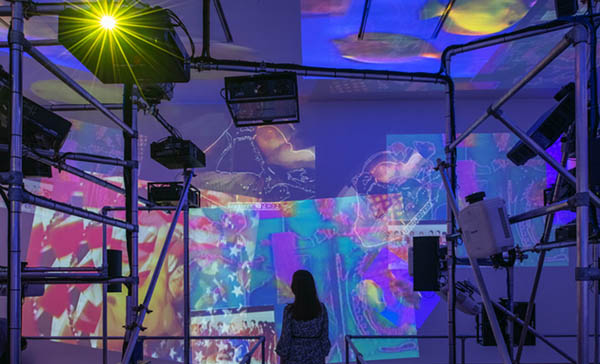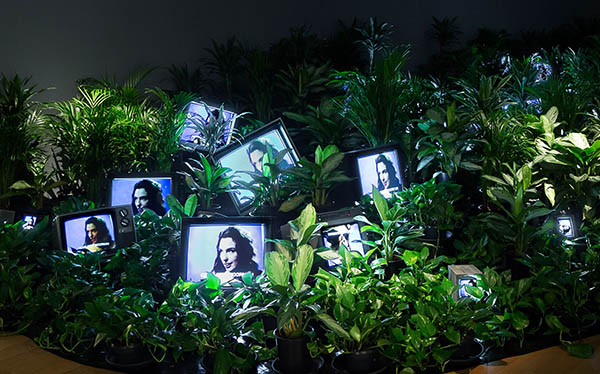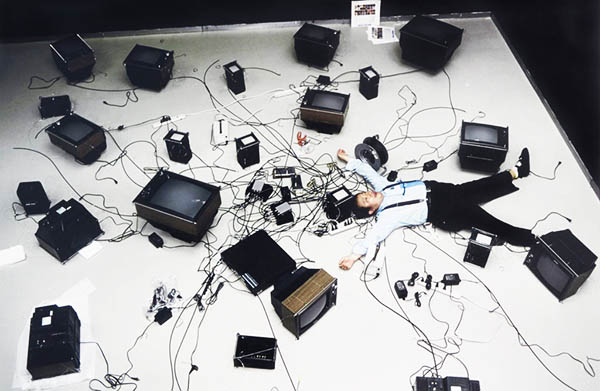SFMOMA 백남준 회고전 'Nam June Paik'(5/8-10/3)
샌프란시스코 현대미술관(SFMOMA)이 5월 8일부터 10월 3일까지 백남준 회고전을 연다. 이 회고전은 2019년 런던 테이트 모던에서 시작되어 암스테르담 스테델리크 뮤지엄을 거쳐서 미국 내에서 열리는 유일한 순회전이다. SFMOMA 전시 후 회고전은 싱가포르 내셔널갤러리에서 막을 내린다.

Nam June Paik, Sistine Chapel, 1993 (installation view, Tate); courtesy the Estate of Nam June Paik; © Estate of Nam June Paik; photo: Andrew Dunkley © Tate
Nam June Paik
May 8–October 3, 2021
SAN FRANCISCO, CA (October 30, 2020; updated April 15, 2021) — Nam June Paik has continued to electrify the art world ever since his 1963 debut of television experiments in Exposition of Music – Electronic Television, his first solo exhibition. Paik challenged visitors to participate by activating modified TV sets and playing radically transformed instruments — blurring the distinction between performer and audience. Playful and interactive, Paik’s immersive environment expanded the boundaries of art, music and technology, and laid the groundwork for his career as the founder of video art.
The San Francisco Museum of Modern Art (SFMOMA) will present the exclusive U.S. exhibition of Nam June Paik, a major retrospective of Paik’s radical and experimental art, on view from May through October 2021. One of the first truly global artists, Paik (1932–2006) foresaw the importance of mass media and new technologies, coining the phrase ‘electronic superhighway’ in 1974 to predict the future of communication in an internet age. The exhibition will celebrate his multidisciplinary and collaborative practice that encompassed art, music, performance and technology, all in dialogue with philosophies and traditions from both Eastern and Western cultures.
Bringing together over 200 works across all media spanning a five-decade career, from early compositions and performances to large-scale video installations and global satellite projects, Nam June Paik offers an in-depth understanding of the artist’s trailblazing practice. Paik’s innovative, irreverent and entertaining works were informed by his musical background and his vision of an interconnected future. Organized by SFMOMA and Tate Modern, London, with additional presentations at the Stedelijk Museum Amsterdam and the National Gallery Singapore, the retrospective will be the first major Paik show in the U.S. in over 20 years and the first ever large-scale survey of his work on the West Coast.
“Nam June Paik is famous for being the historic father of video art, but his groundbreaking and contemporary influence is even more based on his crossover between all media,” said Rudolf Frieling, curator of media arts at SFMOMA. “Paik’s radical visual and musical aesthetic has a natural home here on the West Coast as a place for global connectivity.”

Nam June Paik, TV Garden, 1974–77/2002 (installation view, Stedelijk Museum Amsterdam); Kunstsammlung Nordrhein-Westfalen, Düsseldorf; © Estate of Nam June Paik; photo: Peter Tijhuis
Exhibition Highlights
Organized thematically, the exhibition will unite many of Paik’s most iconic and provocative works from throughout his career. In TV Buddha (1974), an 18th-century wooden Buddha appears to watch itself on a modern television, typifying the influence of Zen Buddhist philosophies on Paik’s approach to art and technology. Also on view will be TV Garden (1974–77/2002), an immersive installation featuring dozens of TV sets alongside lush foliage in a futuristic landscape where technology is an integral part of the natural world.
Nam June Paik will partially restage the artist’s pivotal 1963 solo exhibition, Exposition of Music – Electronic Television, and his concept of “action music” (as Paik said, “Why is it music? Because it is not ‘not music’”) will be demonstrated via musical interfaces and some of Paik’s earliest manipulated televisions.
Unique to SFMOMA’s presentation will be two robots, one each dedicated to composer John Cage and choreographer Merce Cunningham, two of Paik’s key collaborators along with artist Joseph Beuys and cellist Charlotte Moorman. John Cage Robot II (1995) and Merce / Digital (1988), among many other works, will highlight Paik’s creative partnerships and collaborative artistic practice.
The retrospective will culminate in the dazzling installation Sistine Chapel (1993), a mesmerizing riot of sound and images from dozens of projectors, taken from the German pavilion which won the Golden Lion award at the Venice Biennale in 1993. Presented in its largest scale of any venue at SFMOMA, and exceeding that of all other works in the exhibition, Sistine Chapel will envelop the audience in an audio-visual remix of Paik’s past videos and collaborators seen throughout the exhibition.

Timm Rautert, Nam June Paik lying among televisions, Zürich, 1991; © Timm Rautert
About Nam June Paik
Born in Seoul during the Japanese occupation of Korea, Nam June Paik lived and worked in Japan, Germany and the U.S., reflecting a global connectedness that transcended borders and cultural differences. He studied music theory and trained as a musician before experimenting with performance and technology in the 1960s as a means of expanding his artistic production. He developed a multidisciplinary practice across media, and has become synonymous with the electronic image through a prodigious output of manipulated TV sets, live performances, global television broadcasts, single-channel videos and video installations.
Paik collaborated with a community of avant-garde artists and musicians, and played a pivotal role in Fluxus, an international network of artists, composers and poets who engaged in experimental art performances. His groundbreaking work has influenced art, media, music and popular culture for decades, including musicians such as David Bowie, Laurie Anderson and Devo’s Mark Mothersbaugh, among many others.
Online Participatory Component: Video Commune and Electronic Opera #1
In conjunction with Nam June Paik, SFMOMA will present Paik’s work Video Commune online. Originally broadcast on live TV in 1970, Video Commune was an improvised montage of distorted TV imagery accompanied by songs by the Beatles. At the time, Paik invited random passersby into the studio and let them remix video images as they aired. The presentation in the exhibition galleries is a condensed videotape of the broadcast filmed from a TV screen.
Video Commune will be made accessible as a participatory work on SFMOMA’s Nam June Paik exhibition webpage: visitors to the webpage will be invited to watch the silent video from the comfort of their home and create a soundtrack of their choice from a selection of Beatles songs. A second video, Electronic Opera #1, combines abstract electronic patterns with an invitation to the audience to close and open their eyes.
Virtual Public Programs
SFMOMA is proud to present the online film series Dances for Camera: Nam June Paik, Merce Cunningham, Charles Atlas on the museum website from June through August. Dances for Camera features three key works from 1960s San Francisco, 1970s New York, and 1980s London that exemplify the dance film genre. In addition, SFMOMA will host a virtual public performance and streaming program in collaboration with the National Gallery Singapore on September 24.
Catalogue
The exhibition is accompanied by an illustrated catalogue from Tate Publishing. Edited by Sook-Kyung Lee and Rudolf Frieling, it features essays by the editors and contributions from Leontine Coelewij, Grace Deveney, Rachel Jans, Susanne Neuburger, Andrea Nitsche-Krupp, Valentina Ravaglia and David Toop, as well as excerpts of Paik’s own writings.
Venues + Dates
Tate Modern: October 17, 2019–February 9, 2020
Stedelijk Museum Amsterdam: March 14–October 4, 2020
SFMOMA: May 8–October 3, 2021
National Gallery Singapore: December 2021–March 2022






